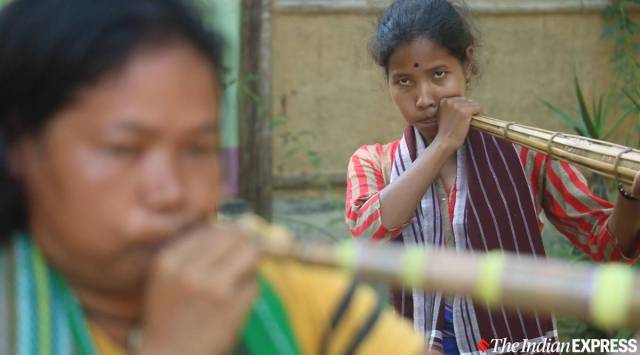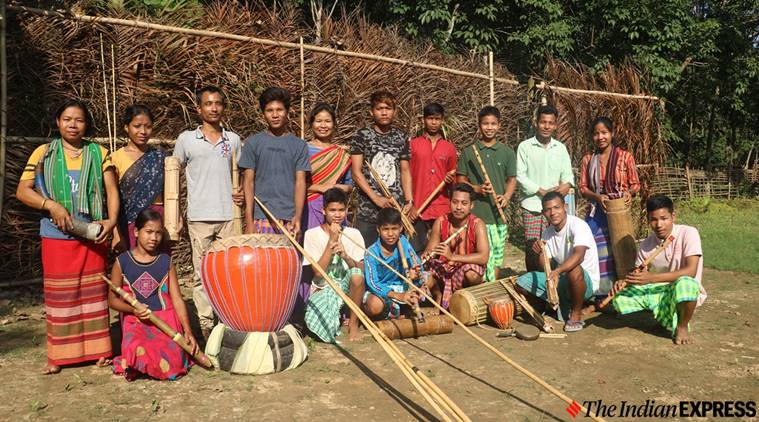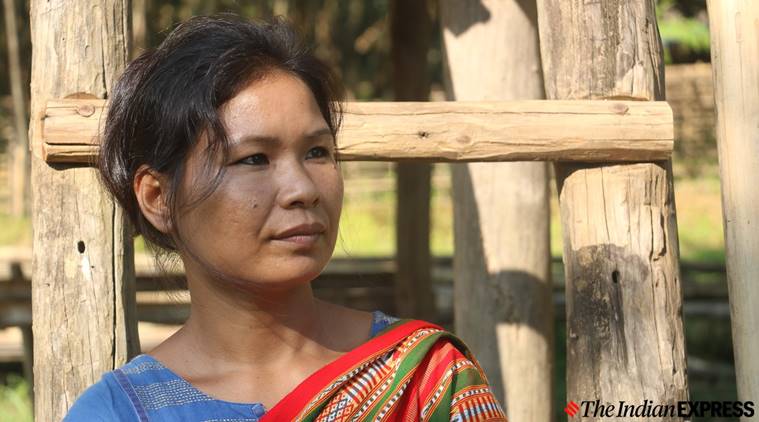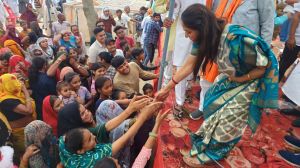- India
- International
How a folk theatre collective in Assam is playing to preserve some unique tribal notes
These are more than just music lessons, but a way to hold on to their tribal identity in Assam.
 Two women of theatre collective, Manchalengka, play the traditional jaapkara. (Express photo by Bhaskar Goswami)
Two women of theatre collective, Manchalengka, play the traditional jaapkara. (Express photo by Bhaskar Goswami)In February, just before the pandemic hit India, as part of ‘University Week’ in which his college was participating, 23-year-old Chidhanta Rabha, lugged a bamboo pole — several feet taller than him — on to a stage in Guwahati. In the orchestral performance featuring popular folk instruments ranging from dhul (drum) to taal (cymbal), the elongated pole stood out.
“We have not seen anything like it before,” one of the judges said, “What is it?”
Chidhanta remembers feeling a hint of pride as he introduced the ‘kara-nol’, a kind of a wooden trumpet, to the audience — he told them it measured six to seven feet, and if played accurately, it made sounds akin to a grieving person, and that it was indigenous to his people: the Rabha community, which primarily inhabited the Goalpara and Kamrup districts of Assam, and parts of Meghalaya, West Bengal and Bangladesh.
 Years before musical instruments became a part of the Manchalengka ecosystem, the troupe performed Rabha language plays. (Express photo by Bhaskar Goswami)
Years before musical instruments became a part of the Manchalengka ecosystem, the troupe performed Rabha language plays. (Express photo by Bhaskar Goswami)
Seven years ago, Chidhanta would have been as clueless as his audience. He only learned of the trumpet’s existence in 2013, when Shimbhu Rabha, a respected elder of his community, received an award for his prowess with the instrument. And it was only in 2018, when he saw a Facebook post about a workshop in traditional folk music by a group called Manchalengka, that Chidhanta first heard and held a kara-nol.
Two years later, Chidhanta is now adept at the kham (a large drum), the jaapkara (a tube horn), and the badungduppa (a stringed bamboo instrument) from several lessons at Manchalengka, a space run by a Rabha theatre collective, located in Goalpara district, amidst verdant paddy fields and acres of rubber plantations as far as the eye can see.

For the Political Science major, these were more than just music lessons, but also a way to hold on to his identity as a Rabha in Assam.
Music Lessons
When 34-year-old Rayanti Rabha launched Manchalengka in 2009, she was driven purely by a “love for theatre and acting.” Trained under Heisnam Kanhailal, noted Manipuri theatre personality, Rayanti’s tryst with the arts started when, at 18, she signed up to act in a play (a Rabha adaptation of Assamese playwright Jyotiprasad Agarwala’s Rupalim) directed by the late Sukracharjya Rabha, well-known Rabha theatre artiste, whose unique no-sound, no-light ‘Under The Sal Tree’ festival has carved a niche of its own.
“My participation back then raised several eyebrows in the village — a girl acting?” remembers Rayanti, “That was not kosher.” It is a Tuesday morning at Manchalengka, and under sunny blue skies, young boys and girls are tinkering on instruments of various shapes and sizes. In the Rabha language, Manchalengka refers to the kingfisher as well as a brass accessory men don while performing the tribe’s traditional dance.
“We always used folk instruments in our plays but sometime back, I thought we needed to do more,” says Rayanti, “There are only a few — very old — people who know how to play these instruments. And fewer still, who want to learn.” Since then, Rayanti and her team have served as a bridge between the two, holding regular workshops at Manchalengka.
Social media helped to get the word out — and many like, Chidhanta, found themselves cycling to the village to learn instruments they had not seen, or even heard before. “I ended up staying for a month on my first visit,” recalls Chidanta, who grew up in a village closeby. “It was something about the place: there was peace, quiet and an understanding for our language and culture like I had never experienced before.”
Years before musical instruments became a part of the Manchalengka ecosystem, the troupe performed Rabha language plays not just in Guwahati, but in Mumbai, Mysore, Pune and beyond. “Somewhere along the way, I realised that our work was driven by more than just love for the arts,” says Rayanti, “Once, speaking a few lines of Rabha in front of an audience of hundred in Bangalore, I remember feeling good. And I came home thinking, at least these hundred people know that a language called Rabha exists.”
 Rayanti Rabha, 34, was Yuva Puruskar of Sangeet Natak Akademi in 2012 for acting. (Express photo by Bhaskar Goswami)
Rayanti Rabha, 34, was Yuva Puruskar of Sangeet Natak Akademi in 2012 for acting. (Express photo by Bhaskar Goswami)
For long years, the Rabhas struggled for political autonomy within Assam, demanding an autonomous council under the Sixth Schedule of the Constitution — the special provision that allows for greater political autonomy and decentralised governance in certain tribal areas of the Northeast. In 1995, the Assam government formed the Rabha Hasong Autonomous Council, a local governing body with rather limited powers to administer Rabha-inhabited conclaves in the state. However, the tribe’s demands to be included under the Sixth Schedule has not been met yet, but frequently voiced, in a bid to maintain their distinct identity. Several tribal communities in Assam have similar demands.
“But I have often wondered — how often do we voice these demands in our own language?” says Rayanti, “For me, linguistic and cultural identity go hand in hand with political identity. Music, art, theatre…language, politics… you can’t save one without saving the other.”
Holding On
Over the years, Manchalengka has become a refuge to many.
“I did not have the opportunity for an education and helped my father run a small paan shop,” says Namita Rabha, 34, who is learning how to play the kara-nol. But at Manchalengka, she found an education, and a home — she has been with the group for a decade now, moving into their campus in 2010.
“Theatre is our passion, but it is also our bread and butter,” says Namita. In the recent months, the Covid-19 lockdown put an end to various performances, and on particularly dark days, the troupe considered “giving it all up.” “But if it takes courage to make theatre your profession, it also takes courage to give it up as your profession,” says Rayanti.
In the first week of October, the group managed to stage a Rabha play, Ora-bisi, written by Rayanti. “It is basically a take on patriarchy,” she says, “I try to do themes which are socially relevant.”
About 20 people from their village assembled — as the troupe performed in a clearing in their compound, demarcated by banana leaves, meant to be a stage.
“It felt really good,” says Namita, “When I play the jaapkara or the kara-nol, I really feel proud — especially because no other boy in my village knows how to,” she says.
According to Upen Rabha Hakacham, a specialist in tribal folklore, culture and society, it was long considered a stigma for women to act, or even play these instruments. “Such instruments, particularly the kara-nol would be used by senior male folk during weddings, accompanied by a ballad,” he says, “Since 1957, under the patronage of the first Rabha playwright and director, the late Prasanna Pam, and later, artiste Rajen Pam, these were slowly popularised, and played on stage, accompanied by the Rabha Kristi Natya (Rabha folk dance).”
According to Hakacham, who is a senior professor in the Assamese Department in Gauhati University, people like Rayanti and Sukracharjya [Rabha] have set aside old taboos, brought them from the stage, to the ground. “They broke barriers — and have taken these items of culture from Rabhas to non-Rabhas, from regional to national to even international audiences,” says Hakacham, adding that cultural and literary aspirations of Rabhas, if studied, go as far back as the 1950s. “It was just that it never had a popular outlet.”
In time, these outlets are only growing. During the lockdown, with his college closed and a lot of free time on hand, Chidhanta, set up a YouTube channel to document facets and ‘untold stories’ of Rabha culture. “I did it for a simple reason — we need to be heard, we need to hold on to what we have, before we lose it all,” says Chidantha. Of the twenty videos uploaded so far, one is devoted entirely to the kara-nol.
Apr 25: Latest News
- 01
- 02
- 03
- 04
- 05







































